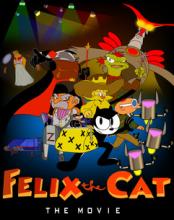Nostalgia Corner: Felix the Cat- The Movie
My generation was the last in America to grow up on an exclusive diet of hand-drawn animation. By the time we entered our teens, computer animation had asserted itself in highly successful films like Toy Story and in trendy TV shows like the Canadian tech-fancy toon Reboot. With the slickness and relative simplicity of CGI, cartoons lost a lot of the depth and fluidity that characterized those late-period traditional toons. Still today, CGI is about spectacle. It's used more often than not to generate ooh's and ah's from the audience, whereas hand-drawn animation (especially in the Western tradition) spent the 80's and 90's attempting to be as complex and expressive as possible. This combination of artistic drive and increased marginalization led to some of the strangest, most affecting cartoons in history. One such hand-drawn oddity was the unlikely Felix the Cat: The Movie, an attempt to revive a beloved character for another generation that, in failing to do so, achieved an unforgettable artistic stamp.
The Felix character has been a part of the cartoon world since 1919. He was born in Pat Sullivan's studio at Paramount Pictures, though animator Otto Messmer claimed that he invented Felix, not Sullivan. Whoever brought that iconic cartoon cat to the screen, Felix became a hit around the world and was one of the most recognizable characters in the silent film era. Ironically, it would be a mouse that knocked Felix off his pedestal. Walt Disney's Mickey launched the talkie cartoon market and Felix didn't transition very well into sound. It would take a revival by Pat Sullivan's assistant Joe Orielo in 1953 to make the Felix most people know today. Orielo gave Felix his iconic Magic Bag of Tricks and created an entire supporting cast of friends and villains.
The Felix movie was yet another revival attempt, this time by Joe Orielo's son, Don. The original intent was to launch a new Felix TV series but the combination of high production costs ($9 million in 1987) and the dark strangeness of the final product kept Felix from another regular television spot.
Felix the Cat: The Movie has little to do with the famous cartoons of the 1950's. Aside from Felix, the Magic Bag and a couple other recognizable characters, the movie consists of a mostly stand-alone plot pulled from an unrelated and considerably more mature fantasy adventure. The movie fits alongside a lot of the cartoon adventures of the era in its intensity and sense of scale. Feature-length toons like The Brave Little Toaster have a similar road movie/peril aesthetic, though Felix sports an unsettling series of bizarre, nightmarish images and high-fantasy gorgeousness. The plot revolves around Princess Oriana, the deposed leader of a dream-like world full of odd creatures and deadly corners who needs someone to help her fight her evil uncle. To see the plucky, shrill-voiced Felix running around a world filled with steam punk fascists and vicious flying heads is more than a little dissonant.
A lot of the weirdness of the Felix movie is the result of the Hungarian animation studio contracted to draw it. Pannonia Filmstudio definitely had impressive credentials but Don Orielo obviously hadn't been paying attention to how much animation and film in general had changed in Eastern Europe in the 70's and 80's. The aesthetic was dark, apocalyptic and surreal; far from the nonthreatening brightness that made Felix famous. Still, Felix the Cat: The Movie did well enough in the home video market to justify occasional rotation on cable TV, most frequently on the Disney Channel. In today's age of carefully crafted scheduling and endlessly streaming original properties, television really isn't the place for oddities like Felix anymore. Like hand-drawn animation itself, the weirdness of botched cartoons is mostly a thing of the past.






